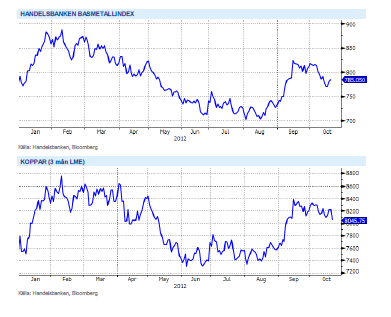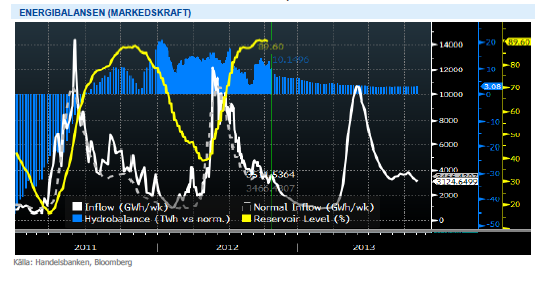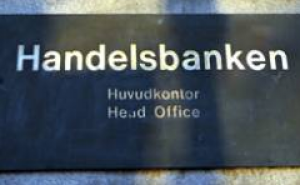Analys
SHB Råvarubrevet 19 oktober 2012
 Efter en ny vecka med blandade makrosignaler är vi någonstans mellan neutrala till positiva till risksentimentet. Riskrallyt drivet av QE3 förstärker makro, speciellt i USA men förväntningarna på den globala återhämningen har skruvats ner de senaste veckorna, kanske för mycket och det finns möjlighet till positiva överraskningar i närtid. Vi tror att valet i USA och ledarskiftet i Kina plus rapport säsongen håller uppe riskviljan de kommande veckorna. Valet i USA tar bort fiscal cliff diskussionen ur fokus vilket är positivt för riskviljan.
Efter en ny vecka med blandade makrosignaler är vi någonstans mellan neutrala till positiva till risksentimentet. Riskrallyt drivet av QE3 förstärker makro, speciellt i USA men förväntningarna på den globala återhämningen har skruvats ner de senaste veckorna, kanske för mycket och det finns möjlighet till positiva överraskningar i närtid. Vi tror att valet i USA och ledarskiftet i Kina plus rapport säsongen håller uppe riskviljan de kommande veckorna. Valet i USA tar bort fiscal cliff diskussionen ur fokus vilket är positivt för riskviljan.
Basmetallerna har åter vänt uppåt efter sitt fall på 6,5 % från toppen i september, vi byter därför fot från neutral till något positivare igen. Råoljan fortsätter handlas i sitt intervall mellan 109 och 117 och vi tycker att fundamenta är väl balanserat och motiverar att vara neutral. Även el, som vi hoppas på inför vintern med nedpressade förväntningar ligger kvar i sitt intervall och vi väntar fortfarande på rätt köpläge. Håll dock el under bevakning, vintern närmar sig och där-med riskerna. El är volatil och när det vänder upp går det snabbt.
Basmetallerna
Har vinden vänt för metallerna?
Efter två veckor med fallande priser på basmetaller har priserna vänt upp denna vecka. Vårt basmetallsindex är upp 1,95 % sedan måndag. Onsdagens besked om bättre än väntad byggaktivitet i USA fick metallerna att stiga på förväntningar om större efterfrågan. Dock vände samtliga metaller ned under fredagen och suddade ut mycket av veckans uppgångar.
Vi har även deltagit på årets LME-vecka som ägde rum under veckan. om vi sammanfattar kontentan av årets LME, så väntar alla på vad som ska hända i Kina efter ledarskapsskiftet. De presentationer som gavs var alla slående lika till innehållet; Kina, Eurokrisen och USA:s fiscal cliff dominerade utan att ge något banbrytande på endera tema. Du som prenumerant kan läsa en separat rapport från LME-veckan som bifogats i utskicket. Vi går från att vara neutrala på basmetaller till något positiv.
Efter två veckor med fallande priser på basmetaller är vi åter positiva. Vi tror på: BASMET H
Ädelmetaller
Fortsatt strejk i Sydafrikas gruvor
Vi lägger ytterligare en vecka med små rörelser bakom oss. Handelsbankens ädelmetallindex har stigit med knappa 0,6 %. Guldet handlas på 1 % lägre priser än förra veckan till följd av bättre än väntat ekonomisk data från både USA och Kina. Vi behåller fortsatt en positiv syn för denna sektor, där centralbankernas stimulanspengar är det främsta skälet.
I Sydafrika fortsätter guldgruvorna kampen att förmå sin arbetskraft att återvända i arbete. AngloGold, 3:e största producenten av guld, har sedan strejken startade den 25 september förlorat 90 000 uns i produktion. 15 000 arbetare av Gold Fields, den fjärde störs-ta producenten, strejkar fortfarande. En del arbetare är åter i arbete vid Gold Fields gruva i Beatrix , men det är för tidigt att avgöra om strejken där har kommit till sitt slut. Rapporter om våldsamheter vid flertalet gruvor verkar inte upphöra.
Vi fortsätter att se centralbankernas nytryckta pengar och framförallt Feds QE3 operation som starkt skäl att vara investerad i ädelmetallerna. Konflikterna i Sydafrika fortsätter och ger stöd åt Platina- och guldpriset. Vi tror på: ADELMET H
Energi
Oljan under press
Priset på olja har pressats under veckan och handlas nu på 112,20 USD/fat, vilket är 2,2 % lägre än samma tid förra veckan. Källor inom industrin hävdar att Saudiarabien producerade 9,77 miljoner fat/dag under september månad. Det är nära till de 10 miljoner fat/dag som pumpats upp under de senaste månaderna. Detta uppväger effekterna av EU:s hårdare sanktioner mot Iran som godkändes 15 oktober. Amerikanska oljelager visade på stigande lager, 2,9 miljoner fat mot förväntade 1,5 miljoner fat.
Elmarknaden och första kvartalet 2013 handlas upp strax under 2 procent denna vecka efter att väderprognoserna slagit om till ett kallare scenario samt stigande priser på både gas och tysk el. Ett ökat intresse för utsläppsrätter efter signaler om att EU-Kommissionen kommer att verka för att minska utbudet framöver. EU-Kommissionen släpper sin nästa rapport den 14 november och allokeringen ser att minska med antingen 400m, 900m eller 1,200m ton och man förväntas dessutom lägga fram en plan för ett globalt direktiv. Utsläppsrätterna har nu stigit med närmare 9 procent på en månad. Annars är det mest fokus på väder (senaste prognos 2-3 grader under normalt för de kommande 10-dagarna) där lägre temperaturer till viss del balanseras av en god tillgång på vatten. Energibalansen visar på ett överskott om ca 10 TWh.
Oljan har sett allt svagare ut och vi fortsätter tycka att underliggande fundamenta är väl balanserad. El börjar se intressant ut inför vintern då riskerna på elmarknaden tilltar men vi låter sektorsynen vara neutral till positiv.
Livsmedel
Torrt för höstvetet i USA
Terminspriser på vete har i veckan gått upp i Chicago men ned något i Paris. Än behövs det mer regn på det nysådda höstvetet i USA, en del småskurar då och då lindrar dock situationen något. Även i Australien är det mestadels torrt för vetet, endast små regnmängder har fallit i de västra och de syd-östra delarna av landet – merparten i marknaden börjar nu förvänta sig en australiensisk veteproduktion ner mot 20 miljoner ton, att jämföra med USDA:s senaste uppskattning om 23 miljoner ton.
I Europa råder mestadels torrt väder nu (även om det knappast känns så i vissa delar av Sverige), vilket gynnar återstående sådd. Inte mycket av den europeiska sådden kvarstår nu, generellt sett har sådden avklarats väl men det myckna regnandet i Storbritannien, som tidigare skapat stora problem med skördearbetet, orsakar nu även ganska stora problem för sådden. De ryska lantbrukarna önskar mer regn, inte minst på grund av högre temperaturer än normalt för säsongen. I Ukraina har det däremot regnat något för mycket, vilket skapar vissa problem med återstående sådd.
Väldigt mycket negativt är nu inprisat i dagens nivå och vi förväntar oss viss svårighet för priserna att nå så mycket högre. Långsiktigt är det svårt att se varför dagens nära rekordhöga priser ska hålla i sig – även om väldigt mycket kan hända till dess.
Vi ser soja, majs och vete som klara säljcase där vi väntar oss prisfall före jul men senast till påsk. Vi tror på: LIVSMEDEL S H
Handelsbankens Råvaruindex

Handelsbankens råvaruindex består av de underliggande indexen för respektive råvara. Vikterna är bestämda till hälften från värdet av global produktion och till hälften från likviditeten i terminskontrakten.
[box]SHB Råvarubrevet är producerat av Handelsbanken och publiceras i samarbete och med tillstånd på Råvarumarknaden.se[/box]
Ansvarsbegränsning
Detta material är producerat av Svenska Handelsbanken AB (publ) i fortsättningen kallad Handelsbanken. De som arbetar med innehållet är inte analytiker och materialet är inte oberoende investeringsanalys. Innehållet är uteslutande avsett för kunder i Sverige. Syftet är att ge en allmän information till Handelsbankens kunder och utgör inte ett personligt investeringsråd eller en personlig rekommendation. Informationen ska inte ensamt utgöra underlag för investeringsbeslut. Kunder bör inhämta råd från sina rådgivare och basera sina investeringsbeslut utifrån egen erfarenhet.
Informationen i materialet kan ändras och också avvika från de åsikter som uttrycks i oberoende investeringsanalyser från Handelsbanken. Informationen grundar sig på allmänt tillgänglig information och är hämtad från källor som bedöms som tillförlitliga, men riktigheten kan inte garanteras och informationen kan vara ofullständig eller nedkortad. Ingen del av förslaget får reproduceras eller distribueras till någon annan person utan att Handelsbanken dessförinnan lämnat sitt skriftliga medgivande. Handelsbanken ansvarar inte för att materialet används på ett sätt som strider mot förbudet mot vidarebefordran eller offentliggörs i strid med bankens regler.
Analys
Brent crude ticks higher on tension, but market structure stays soft

Brent crude has climbed roughly USD 1.5-2 per barrel since Friday, yet falling USD 0.3 per barrel this mornig and currently trading near USD 67.25/bbl after yesterday’s climb. While the rally reflects short-term geopolitical tension, price action has been choppy, and crude remains locked in a broader range – caught between supply-side pressure and spot resilience.

Prices have been supported by renewed Ukrainian drone strikes targeting Russian infrastructure. Over the weekend, falling debris triggered a fire at the 20mtpa Kirishi refinery, following last week’s attack on the key Primorsk terminal.
Argus estimates that these attacks have halted ish 300 kbl/d of Russian refining capacity in August and September. While the market impact is limited for now, the action signals Kyiv’s growing willingness to disrupt oil flows – supporting a soft geopolitical floor under prices.
The political environment is shifting: the EU is reportedly considering sanctions on Indian and Chinese firms facilitating Russian crude flows, while the U.S. has so far held back – despite Bessent warning that any action from Washington depends on broader European participation. Senator Graham has also publicly criticized NATO members like Slovakia and Hungary for continuing Russian oil imports.
It’s worth noting that China and India remain the two largest buyers of Russian barrels since the invasion of Ukraine. While New Delhi has been hit with 50% secondary tariffs, Beijing has been spared so far.
Still, the broader supply/demand balance leans bearish. Futures markets reflect this: Brent’s prompt spread (gauge of near-term tightness) has narrowed to the current USD 0.42/bl, down from USD 0.96/bl two months ago, pointing to weakening backwardation.
This aligns with expectations for a record surplus in 2026, largely driven by the faster-than-anticipated return of OPEC+ barrels to market. OPEC+ is gathering in Vienna this week to begin revising member production capacity estimates – setting the stage for new output baselines from 2027. The group aims to agree on how to define “maximum sustainable capacity,” with a proposal expected by year-end.
While the IEA pegs OPEC+ capacity at 47.9 million barrels per day, actual output in August was only 42.4 million barrels per day. Disagreements over data and quota fairness (especially from Iraq and Nigeria) have already delayed this process. Angola even quit the group last year after being assigned a lower target than expected. It also remains unclear whether Russia and Iraq can regain earlier output levels due to infrastructure constraints.
Also, macro remains another key driver this week. A 25bp Fed rate cut is widely expected tomorrow (Wednesday), and commodities in general could benefit a potential cut.
Summing up: Brent crude continues to drift sideways, finding near-term support from geopolitics and refining strength. But with surplus building and market structure softening, the upside may remain capped.
Analys
Volatile but going nowhere. Brent crude circles USD 66 as market weighs surplus vs risk

Brent crude is essentially flat on the week, but after a volatile ride. Prices started Monday near USD 65.5/bl, climbed steadily to a mid-week high of USD 67.8/bl on Wednesday evening, before falling sharply – losing about USD 2/bl during Thursday’s session.

Brent is currently trading around USD 65.8/bl, right back where it began. The volatility reflects the market’s ongoing struggle to balance growing surplus risks against persistent geopolitical uncertainty and resilient refined product margins. Thursday’s slide snapped a three-day rally and came largely in response to a string of bearish signals, most notably from the IEA’s updated short-term outlook.
The IEA now projects record global oversupply in 2026, reinforcing concerns flagged earlier by the U.S. EIA, which already sees inventories building this quarter. The forecast comes just days after OPEC+ confirmed it will continue returning idle barrels to the market in October – albeit at a slower pace of +137,000 bl/d. While modest, the move underscores a steady push to reclaim market share and adds to supply-side pressure into year-end.
Thursday’s price drop also followed geopolitical incidences: Israeli airstrikes reportedly targeted Hamas leadership in Doha, while Russian drones crossed into Polish airspace – events that initially sent crude higher as traders covered short positions.
Yet, sentiment remains broadly cautious. Strong refining margins and low inventories at key pricing hubs like Europe continue to support the downside. Chinese stockpiling of discounted Russian barrels and tightness in refined product markets – especially diesel – are also lending support.
On the demand side, the IEA revised up its 2025 global demand growth forecast by 60,000 bl/d to 740,000 bl/d YoY, while leaving 2026 unchanged at 698,000 bl/d. Interestingly, the agency also signaled that its next long-term report could show global oil demand rising through 2050.
Meanwhile, OPEC offered a contrasting view in its latest Monthly Oil Market Report, maintaining expectations for a supply deficit both this year and next, even as its members raise output. The group kept its demand growth estimates for 2025 and 2026 unchanged at 1.29 million bl/d and 1.38 million bl/d, respectively.
We continue to watch whether the bearish supply outlook will outweigh geopolitical risk, and if Brent can continue to find support above USD 65/bl – a level increasingly seen as a soft floor for OPEC+ policy.
Analys
Waiting for the surplus while we worry about Israel and Qatar

Brent crude makes some gains as Israel’s attack on Hamas in Qatar rattles markets. Brent crude spiked to a high of USD 67.38/b yesterday as Israel made a strike on Hamas in Qatar. But it wasn’t able to hold on to that level and only closed up 0.6% in the end at USD 66.39/b. This morning it is starting on the up with a gain of 0.9% at USD 67/b. Still rattled by Israel’s attack on Hamas in Qatar yesterday. Brent is getting some help on the margin this morning with Asian equities higher and copper gaining half a percent. But the dark cloud of surplus ahead is nonetheless hanging over the market with Brent trading two dollar lower than last Tuesday.

Geopolitical risk premiums in oil rarely lasts long unless actual supply disruption kicks in. While Israel’s attack on Hamas in Qatar is shocking, the geopolitical risk lifting crude oil yesterday and this morning is unlikely to last very long as such geopolitical risk premiums usually do not last long unless real disruption kicks in.
US API data yesterday indicated a US crude and product stock build last week of 3.1 mb. The US API last evening released partial US oil inventory data indicating that US crude stocks rose 1.3 mb and middle distillates rose 1.5 mb while gasoline rose 0.3 mb. In total a bit more than 3 mb increase. US crude and product stocks usually rise around 1 mb per week this time of year. So US commercial crude and product stock rose 2 mb over the past week adjusted for the seasonal norm. Official and complete data are due today at 16:30.
A 2 mb/week seasonally adj. US stock build implies a 1 – 1.4 mb/d global surplus if it is persistent. Assume that if the global oil market is running a surplus then some 20% to 30% of that surplus ends up in US commercial inventories. A 2 mb seasonally adjusted inventory build equals 286 kb/d. Divide by 0.2 to 0.3 and we get an implied global surplus of 950 kb/d to 1430 kb/d. A 2 mb/week seasonally adjusted build in US oil inventories is close to noise unless it is a persistent pattern every week.
US IEA STEO oil report: Robust surplus ahead and Brent averaging USD 51/b in 2026. The US EIA yesterday released its monthly STEO oil report. It projected a large and persistent surplus ahead. It estimates a global surplus of 2.2 m/d from September to December this year. A 2.4 mb/d surplus in Q1-26 and an average surplus for 2026 of 1.6 mb/d resulting in an average Brent crude oil price of USD 51/b next year. And that includes an assumption where OPEC crude oil production only averages 27.8 mb/d in 2026 versus 27.0 mb/d in 2024 and 28.6 mb/d in August.
Brent will feel the bear-pressure once US/OECD stocks starts visible build. In the meanwhile the oil market sits waiting for this projected surplus to materialize in US and OECD inventories. Once they visibly starts to build on a consistent basis, then Brent crude will likely quickly lose altitude. And unless some unforeseen supply disruption kicks in, it is bound to happen.
US IEA STEO September report. In total not much different than it was in January
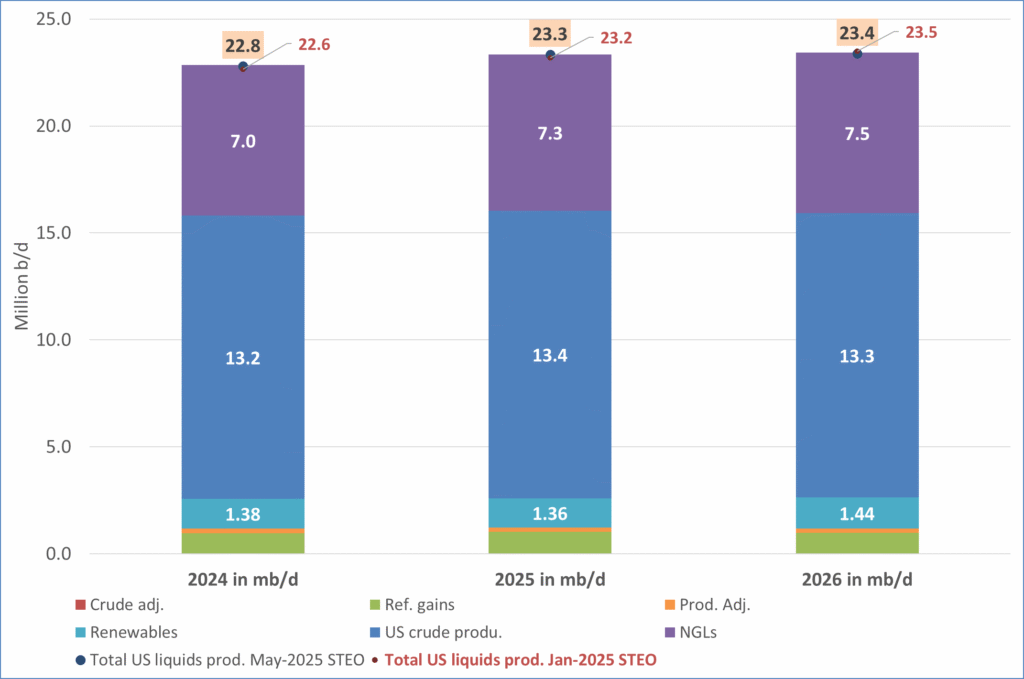
US IEA STEO September report. US crude oil production contracting in 2026, but NGLs still growing. Close to zero net liquids growth in total.
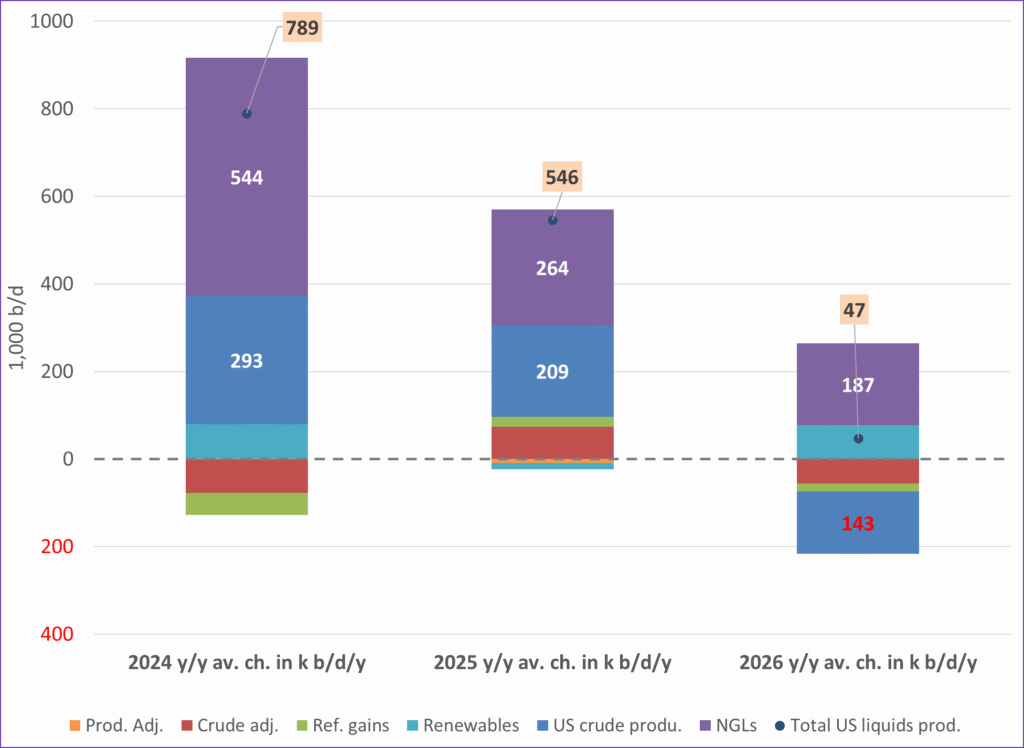
-

 Nyheter4 veckor sedan
Nyheter4 veckor sedanMeta bygger ett AI-datacenter på 5 GW och 2,25 GW gaskraftverk
-
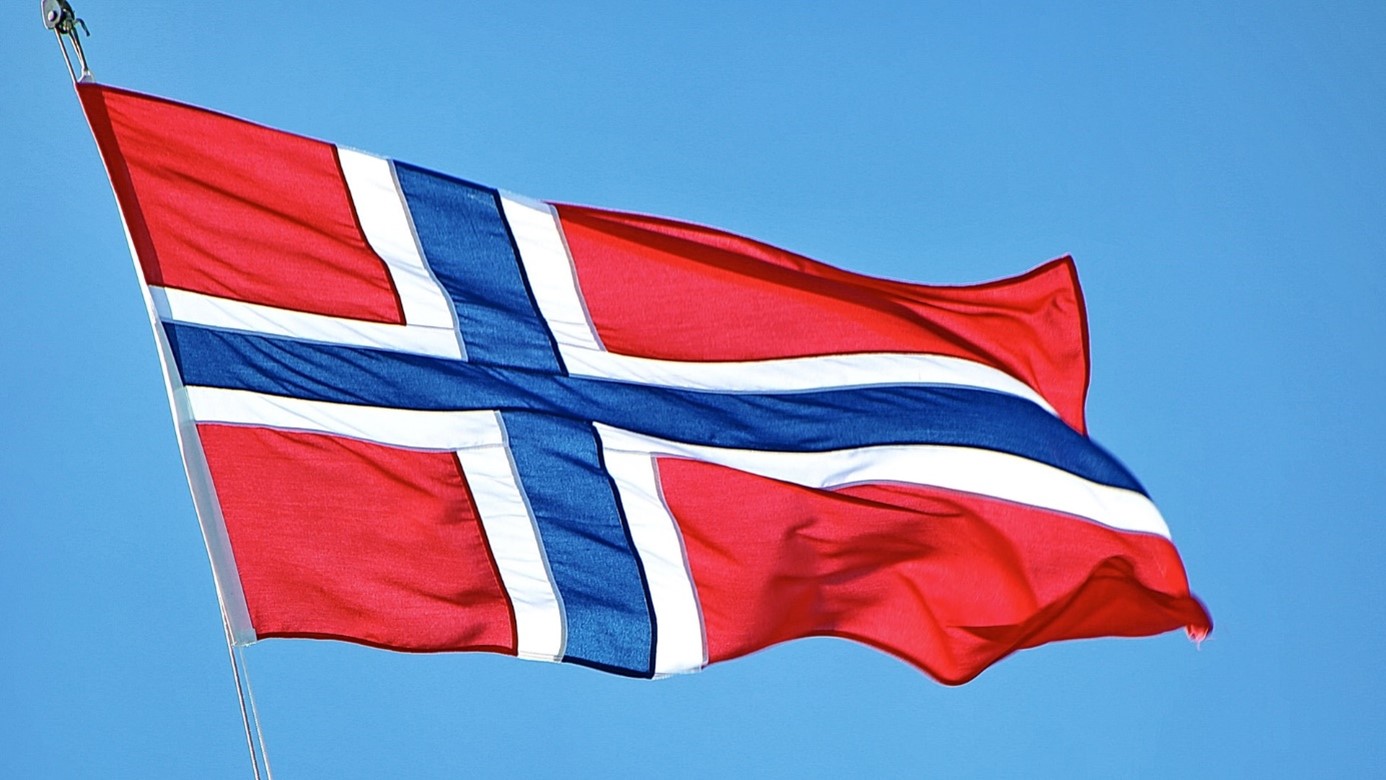
 Nyheter4 veckor sedan
Nyheter4 veckor sedanAker BP gör ett av Norges största oljefynd på ett decennium, stärker resurserna i Yggdrasilområdet
-

 Nyheter4 veckor sedan
Nyheter4 veckor sedanEtt samtal om koppar, kaffe och spannmål
-

 Analys4 veckor sedan
Analys4 veckor sedanBrent sideways on sanctions and peace talks
-

 Nyheter4 veckor sedan
Nyheter4 veckor sedanSommarens torka kan ge högre elpriser i höst
-

 Analys4 veckor sedan
Analys4 veckor sedanBrent edges higher as India–Russia oil trade draws U.S. ire and Powell takes the stage at Jackson Hole
-
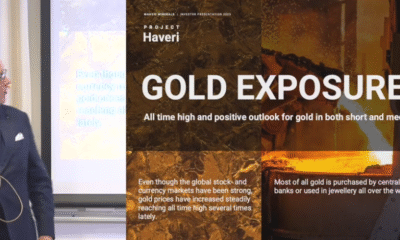
 Nyheter3 veckor sedan
Nyheter3 veckor sedanMahvie Minerals är verksamt i guldrikt område i Finland
-

 Analys3 veckor sedan
Analys3 veckor sedanIncreasing risk that OPEC+ will unwind the last 1.65 mb/d of cuts when they meet on 7 September



